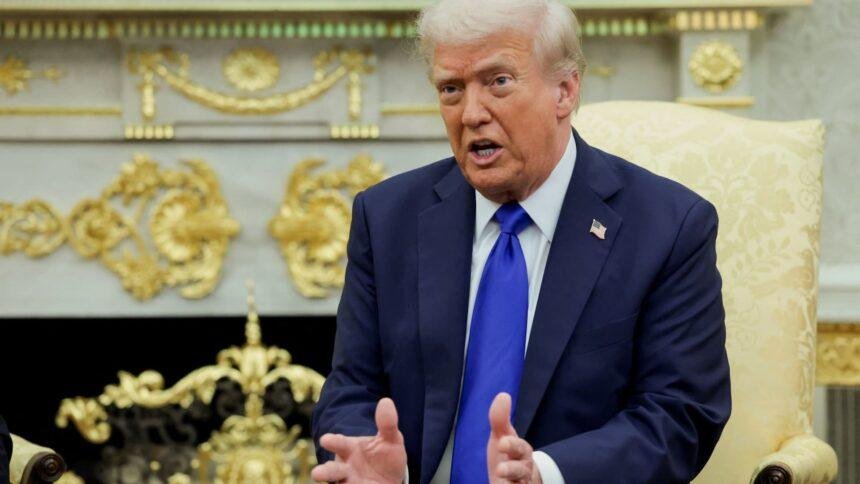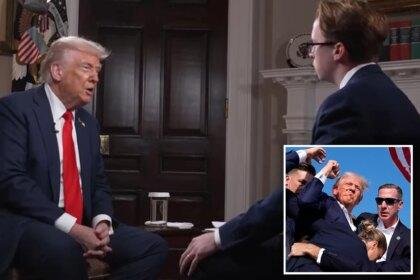Uncertainty Surrounds Federal Workers’ Back Pay Amid Ongoing Government Shutdown
As the government shutdown enters its second week, President Donald Trump has stirred controversy by suggesting that some federal employees who have been furloughed may not receive back pay upon their return to work. This statement has raised eyebrows and ignited a debate over the implications for federal workers and the ongoing political standoff in Washington.
The Context of the Shutdown
The current government shutdown, which began on October 1, 2025, has resulted in the furlough of thousands of federal employees. This situation is reminiscent of previous shutdowns, notably the 2018-2019 standoff that lasted 35 days, during which federal workers faced similar uncertainties regarding their pay. The shutdowns often stem from political disagreements over budget allocations and policy priorities, with the current impasse largely attributed to disputes between the Trump administration and Senate Democrats.
Conflicting Messages from the Administration
On Tuesday, President Trump’s comments came shortly after a draft memo from the White House circulated, indicating that furloughed employees might not be guaranteed back pay. This memo contradicts earlier guidance from the U.S. Office of Personnel Management (OPM), which had assured that furloughed workers would receive retroactive pay once the funding lapse was resolved.
The President’s remarks, made during a meeting with Canadian Prime Minister Mark Carney, suggested a more nuanced approach to back pay. “It really depends on who you’re talking about,” Trump stated, implying that not all furloughed workers would be treated equally. This statement has led to confusion and concern among federal employees, many of whom rely on their salaries to support their families.
Legal Framework and Implications
The Government Employee Fair Treatment Act, signed into law by Trump following the last shutdown, stipulates that furloughed employees “shall be paid for the period of the lapse in appropriations.” However, a White House official clarified that the administration believes Congress must specifically appropriate funds for back pay, a stance that has drawn criticism from labor unions and federal employee advocates.
Everett Kelley, president of the American Federation of Government Employees (AFGE), responded vehemently to the administration’s interpretation. He argued that the notion of withholding back pay is a misinterpretation of the law and inconsistent with the administration’s previous guidance. “The livelihoods of the patriotic Americans serving their country in the federal government are not bargaining chips in a political game,” Kelley stated, calling for an end to the shutdown and a resolution to the ongoing political impasse.
Political Maneuvering and Future Consequences
The Trump administration’s comments regarding back pay appear to be part of a broader strategy to pressure Senate Democrats into supporting a Republican proposal for a stopgap funding bill. This bill aims to maintain government funding at current levels until late November, but it faces significant opposition from Democrats, who are advocating for the extension of enhanced premium tax credits under the Affordable Care Act.
As the shutdown continues, the administration has warned that the situation could lead to permanent layoffs of federal workers, a scenario that would mark a significant departure from past shutdowns, which typically resulted in temporary furloughs. Trump indicated that he would provide more information on potential job losses in the coming days, stating, “It’ll be substantial, and a lot of those jobs will never come back.”
Historical Comparisons and Broader Implications
Historically, government shutdowns have often been used as political tools, with both parties leveraging the situation to gain concessions. The current standoff echoes the 1995-1996 shutdown, which was marked by similar disputes over budgetary priorities and resulted in significant public backlash against the politicians involved.
The implications of the current shutdown extend beyond the immediate concerns of federal workers. The uncertainty surrounding back pay and job security could have lasting effects on employee morale and public trust in government institutions. Moreover, the potential for permanent layoffs raises questions about the future of the federal workforce and the services it provides to the American public.
Conclusion
As the government shutdown drags on, the uncertainty surrounding federal workers’ back pay remains a contentious issue. President Trump’s recent comments have added to the confusion, highlighting the complexities of the legal and political landscape. With both parties entrenched in their positions, the path forward remains unclear. The stakes are high, not only for the thousands of federal employees affected but also for the broader implications of governance and public trust in the federal system. As the situation evolves, the need for a bipartisan resolution becomes increasingly urgent.










